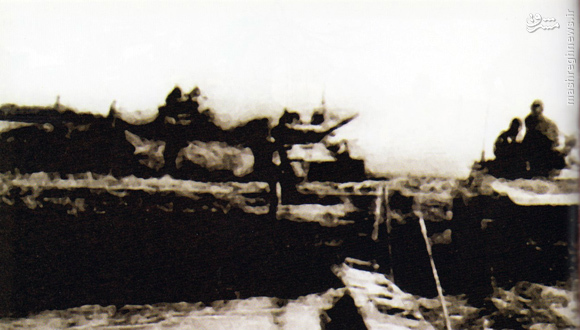Sites
Mared
Written by: Mohsen Shirmuhammad,
Translated by: Hadi Qorbanyar
86 Views
The Mared village, located in Khuzestan Province (along the Karun River), was occupied by the Iraqi army in the early days of the Iran–Iraq War. It was liberated a year later during Operation Thamen al-Aemmah (as).
Mared is a village in Khorramshahr which is located 18 kilometers north of Abadan on the western side of the Abadan–Ahvaz Road.[1] When the war began, the Iraqi army—unable to cross the Arvand Rud and facing difficulties advancing through Khorramshahr—devised a plan to occupy Abadan by crossing the Karun River via Mared and then advancing toward the Bahmanshir River.[2]
In the early hours of October 11, 1980,[3] Iraq’s 6th Armored Brigade established a bridgehead from the Karun River to the Ahvaz–Khorramshahr Road, about two kilometers wide, and installed a PMP-floating bridge across the river.[4] Iraqi troops crossed the river without encountering resistance from Iranian forces, due to their shortage of personnel and the absence of an effective command and control system.[5] A small number of Iranian troops were, however, dispatched to Mared to halt the Iraqi advance, but the flat, open terrain and lack of adequate equipment made it impossible to hold the enemy back.[6]
After securing the area, the Iraqi forces reached the Ahvaz–Abadan Road and cut off around 900 civilians who were fleeing Abadan toward Ahvaz. The men were captured, while the women and children were forced to wander through the desert and return to Abadan.[7]
The Iraqis then reinforced their positions east of the Karun River, and on October 13, 1980, occupied Mared. The following morning, they moved toward the Mahshahr–Abadan Road, and, following its occupation, fully encircled Abadan Island from the landward approach.[8] In Mared, Iraqi troops executed several local Arab residents and took others as prisoners.[9]
Although Iraq’s main objective in crossing the Karun River was to reach Abadan, it was also necessary to expand the northern bridgehead in order to secure the area around the Karun River bridges. Therefore, Iraqi forces pushed forward several hundred meters north toward the village of Salmaniyeh (north of Abadan).[10] This gave Iraq a highly strategic bridgehead east of the Karun, opening the way to Abadan Island.[11] On December 10, 1980, the Iraqi forces installed another bridge in Mared, north of the previous one across the Karun River. Due to the dense forest and poor visibility in the area, Iranian artillery and mortar units were unable to effectively target that area.[12] On December 18, 1980, the Army Arvand Headquarters drafted a plan to push Iraqi forces back from the eastern bank of the Karun River and to liberate the roads connecting Ahvaz and Mahshahr to Abadan.[13] This plan, named Tavakkol, was designed to be carried out in two phases. In the first phase, the 37th Armored Brigade of the Army would launch an attack along the east–west axis north of the Mahshahr–Abadan Road, target the forward edge of the enemy’s bridgehead, and capture the Mared Bridge.[14] This operation took place on January 10, 1981, but was unsuccessful.[15]
After Operation Modon Heights—jointly launched by the Army and IRGC on May 15, 1981, north of Abadan, and resulting in the area’s liberation—[16] plans were soon underway for a follow-up operation in the southern part of the occupied eastern Karun region. This new operation, named “Commander-in-Chief, Khomeini, Spirit of God”, was conducted in the northern part of this area. The plan included digging a canal near Mared to shorten the distance between Iranian forces and the enemy lines. Accordingly, a canal measuring 1,750 meters long, 0.5 meters wide, and 1.4 meters deep was excavated over three months, extending to within 250 meters of the enemy’s defensive line. Supported by an artillery battery from the Iranian Army, 300 IRGC and Basij members participated in this operation. The operation began at 3:40 AM on June 11, 1981, with a ten-minute artillery barrage. Then, Iranian troops attacked the enemy from two axes, advancing six kilometers by 7 AM. The Iraqi response was intense, as they tried for a week to reclaim the liberated area. On the first day, Iranian forces partially withdrew from some areas to consolidate their gains. However, using the dirt berm built on the first night of the operation, they held their ground and pushed back enemy counterattacks. This operation liberated approximately 4 square kilometers of south of Salmaniyeh, and brought Iranian forces closer to the Mared Bridge. As a result, the Iraqis dismantled this bridge and turned instead to the Qasbeh and Haffar bridges on the Karun.[17]
Mared remained under Iraqi occupation until Operation Thamen al-Aemmah (as) on September 27, 1981.[18] During this period, several units of Iraq’s Jaish al-Shaabi and the main headquarters of the 6th Iraqi Brigade were stationed in the village.[19] Moreover, on September 11, 1981, a commando company of Iraqi special forces was deployed to Mared.[20]
In Operation Thamen al-Aemmah (as) on September 27, 1981, the 77th Division of the Army, together with IRGC units, was tasked with taking back the occupied areas east of the Karun River.[21] After two days, Iranian forces not only pushed the enemy back from the eastern bank of the river, but also broke the siege of Abadan.[22]
In the Darkhovein axis (north of Abadan), the 3rd Brigade of the 77th Division, alongside the IRGC units, liberated Mared and seized the Qasbeh Bridge.[23]
According to the 2011 national census, the Mared village had only 16 residents (7 households) and 5 residential units.[24]
An earth dam was constructed on the Karun River in 2021 to improve the water quality of the Bahmanshir, prevent saltwater intrusion, and enhance the drinking water supply for Abadan. The dam is 190 meters long, with a crest width of 11 meters and an approximate height of 19 meters. This dam blocked the river, separated fresh and saltwater, and cut off the Karun’s direct connection to the Persian Gulf, thereby improving Abadan’s water quality.[25]
[1] Pourjabbari, Pejman, Atlas-e Joghrafiya-ye Hemaasi: Khuzestan dar Jang (Epic Geography Atlas: Khuzestan in War), Vol. 1, Tehran: Sarir, 1389, p. 41.
[2] Ibid., p. 195.
[3] Shirmuhammad, Mohsen, Cheshman-e Oqaab: Hemaase-ye Gordan-e 11 Shenasaayi-ye Taktiqi-ye Niru-ye Havaaei va Amaliyaat-e Aksbardari-ye Havaaei dar Defa Muqaddas (Eagle Eyes: The Epic of Tactical Reconnaissance Battalion 11 and Aerial Photography Operations in the Sacred Defense), Tehran: Markaz-e Enteshaarat-e Rahbordi-ye NAHAJA, 1396, p. 160.
[4] Bani-Lohe, Seyyed Ali va Digaran, Nabardha-ye Sharq-e Karun be Revayat-e Farmandehan (Battles East of Karun as Told by Commanders), Tehran: Markaz-e Motaleat va Tahqiqat-e Jang, 1379, p. 54.
[5] Sarvari, Ruhullah and Abolqasem Javdani, Amaliyaat-e Thamen al-Aemmah (as) (Operation Thamen al-Aemmah (as)), Tehran: Nashr-e AJA, 1390, p. 51.
[6] Pourjabbari, Pejman, Ibid., p. 41.
[7] Habibi, Abolqasem, Atlas-e Rahnamaye 6: Abadan dar Jang (Atlas 6: Abadan in War), Tehran: Markaz-e Motaleat va Tahqiqat-e Jang, 1382, p. 75.
[8] Bani-Lohe, Seyyed Ali va Digaran, Ibid., p. 54.
[9] Saleh, Elham, Shekast-e Mohasereh dar 9 Saat (Breaking the Siege in 9 Hours), Markaz-e Motaleat va Tahqiqat-e Farhang va Adab-e Paydaari, Tarikh-e Shafahi-ye Iran, 3 Mehr 1397, www.oral-history.ir/print.php?id=8072
[10] Bani-Lohe, Seyyed Ali va Digaran, Ibid., p. 54.
[11] Ibid., p. 55.
[12] Soleimani-Khah, Nematollah, (There is no Place for the Enemy on this Side of Arvand), Tehran: Markaz-e Asnad va Tahqiqat-e Defa Muqaddas, 1393, p. 405.
[13] Sadeqi-Gouya, Nejatali, Defa az Abadan: Defa az Abadan dar Saal-e Aval-e Jang-e Tahmili (Defending Abadan: Defending Abadan in the First Year of the Imposed War), Tehran: Enteshaarat-e Iran-e Sabz, 1391, p. 173; Doroudian, Muhammad, Tajziyeh va Tahlil-e Jang-e Iran va Araq: Baazyaabi-ye Sobaat (Analysis of the Iran–Iraq War: Restoring Stability), Vol. 2, Tehran: Markaz-e Motaleat va Tahqiqat-e Jang, 1378, p. 115.
[14] Sadeqi-Gouya, Nejatali, Ibid.; Saremi, Majid, Tip-e 37 Zerehi dar Amaliyaat-e Thamen al-Aemmah (as) (Armored Brigade 37 in Operation Amaliyaat-e Thamen al-Aemmah (as)), Tehran: Enteshaarat-e Iran-e Sabz, 1389, p. 31.
[15] Husseani, Seyyed Yaqoub, Nabardha-ye Mantaqe-ye Khorramshahr va Abadan dar Saal-e Aval-e Jang-e Tahmili (Battles of the Khorramshahr and Abadan in the First Year of the Imposed War), Tehran: Enteshaarat-e Iran-e Sabz, 1396, Pp. 370–371.
[16] Fath-e Tappeha-ye Modon-e Abadan va Naqsh-e Jahad-e Sazandegi dar Piroozi-ye Amaliyaat (Liberation of Abadan’s Modon Hills and the Role of Jahad-e Sazandegi Organization in the Success of the Operation), Khabargozari-e Defa Muqaddas, 22 Ordibehesht 1394, www.defapress.ir/fa/news/46344
[17] Pourjabbari, Pejman, Ibid., p. 39.
[18] Ibid., p. 41.
[19] Sarvari, Ruhllah va Abolqasem Javdani, Ibid., p. 56.
[20] Soleimani-Khah, Nematollah, Ibid., p. 473.
[21] Bani-Lohe, Seyyed Ali va Digaran, Ibid., p. 176.
[22] Jafari, Mojtaba, Atlas-e Nabardha-ye Mandegar (Atlas of Lasting Battles), Tehran: Sooreh-ye Sabz, 1393, 35th Ed., p. 64.
[23] Soleimani-Khah, Nematollah, Ibid., Pp. 475–477.
[24] www.addressmap.ir/45234/
[25] Farmandar: Sakht-e Sadd-e Mared Kifiyat-e Aab-e Abadan ra Afzayesh Daad (Governor: Construction of Mared Dam Improved Abadan’s Water Quality), IRNA, 9 Tir 1400, www.irna.ir/news/84389178





